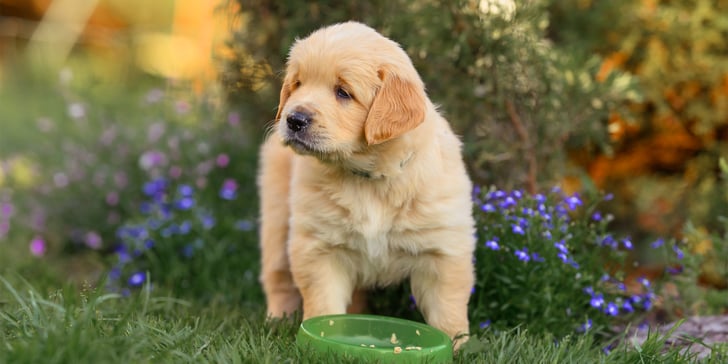Golden Retriever Weight Chart - Puppy Growth Guide
Index:



Introduction
We know bringing home a Golden Retriever puppy fills your heart with joy. But watching your pup grow can bring questions too.
As they start eating more and zooming around your living room, you might find yourself wondering, "Is my little furball growing at the right pace?"
That's why we've put together this handy Golden Retriever weight chart to help you keep tabs on their progress from those tiny newborn days right up to their full-grown, tail-wagging glory.
Key takeaways
Golden Retriever puppies grow rapidly in the first year, reaching most of their adult weight by 12 months.
Males typically weigh 29-34 kg as adults, while female Goldens range from 25-29 kg.
Use a growth chart to monitor puppy growth and spot issues early.
A balanced diet, starting with quality puppy food supports joints and bones during growth and development.
Chat with your veterinarian if your pooch is growing too quickly, slowly or carrying excess weight.



Golden Retriever puppy growth stages
The Golden Retriever’s growth comes in stages. In puppyhood, they grow rapidly, often doubling weight monthly at first.
From birth to 8 weeks, their weight jumps from about 0.5 kg to 4-7 kg. By 3 months, expect another spurt where they reach 7-12 kg.
They hit half their adult height around 4-5 months, but growth slows after 6 months.
Neutering can also affect their growth rate. With Golden's, you should neuter them after 1 year to let joints and bones develop fully. Always discuss timing with your vet, since health, sex, and behaviour should be considered.
We also understand concerns about rapid growth in puppies. Growing too fast can put extra strain on developing bones and joints, so it’s important to feed measured portions of a large-breed puppy food to support steady, healthy growth.
For feeding, our grain-free food guide can be a good resource if your pet has been recommended for this type of diet.



Golden Retriever weight chart in kg
You can help to track your pup's progress with this weight chart. Remember that weights vary by gender and lines, so use them as a guide only. Male Golden Retrievers are generally heavier than females.
Note: There can be a wide variation in weights within any breed.
Males reach 23 to 24 inches (58-61 cm) tall, females 21.5 to 22.5 inches tall (55-57 cm). Some hit 75 pounds (34 kg), but averages are lower.
It can be helpful to track your golden retriever's weight using a weight chart on a weekly basis. This allows you to monitor their growth and ensure they are within the ideal range.
If you notice that your dog's weight is significantly below or above the recommended range, it is important to consult your veterinarian for guidance and support.
In the end, raising a Golden is all about the joy they bring, from puppy antics to loyal companionship. With this guide in hand, you'll navigate their growth like a pro, here's to many tail wagging adventures ahead!



FAQs about Golden Retriever weight
When do Golden Retrievers reach full weight?
Most hit their peak by 18 months, though some take until 2 years to fully fill out. Our growth chart is perfect for keeping an eye on things.
What if my puppy is underweight?
Reach out to your vet; they can help tweak the puppy food or rule out any health quirks. Sometimes it's just a matter of finding the right chow, but professional guidance ensures everything's okay.
Do male and female weights differ much?
Yep, males are typically 4 to 5 kg heavier than females, blame it on those extra muscles (or maybe the extra treats they sneak).
Can neutering affect growth?
It could slow things down if done too early, so discussing timing with your vet is crucial to support proper development.
What's the average adult weight?
Males average 29 to 34 kg, females 25 to 29 kg. Just watch for excess weight, a trim pup is a happy pup, and your vet can advise on maintaining a healthy range.
Waggel Pet Insurance
Need more help? You're in luck if you're a Waggel Pet Insurance member. Along with our excellent coverage, we offer access to a 24/7 online vet to answer all your sticky questions, especially if you need grooming assistance.
Not a member? Why not get a quote now and cover your furry friend for a range of illnesses, all while enjoying our amazing perks and rewards.
Want more like this?
Get updates from us with helpful info, advice, answers to frequently asked questions and much more.
Index:
Related posts:
Get your quote
Along with our excellent coverage, we offer access to a 24/7 online vet to answer all your sticky questions.





